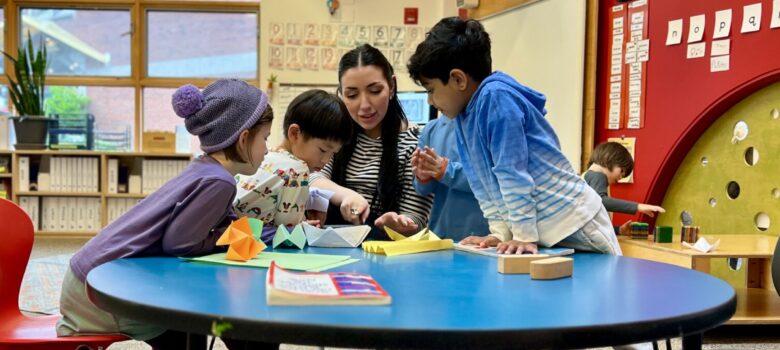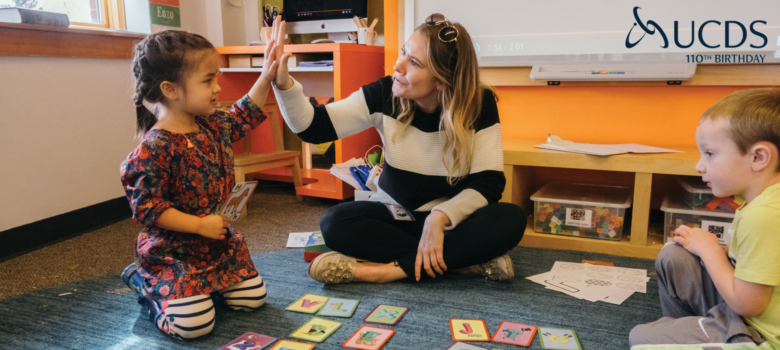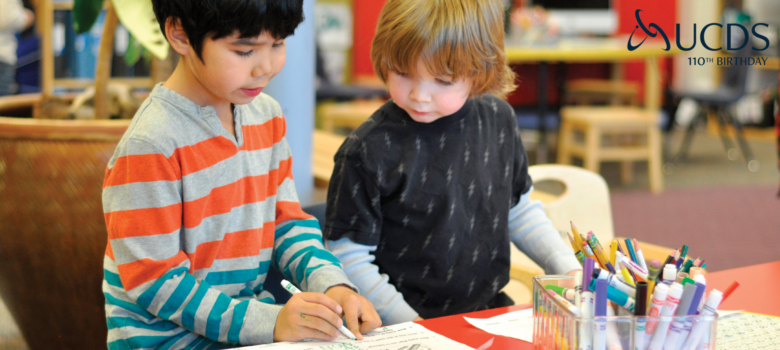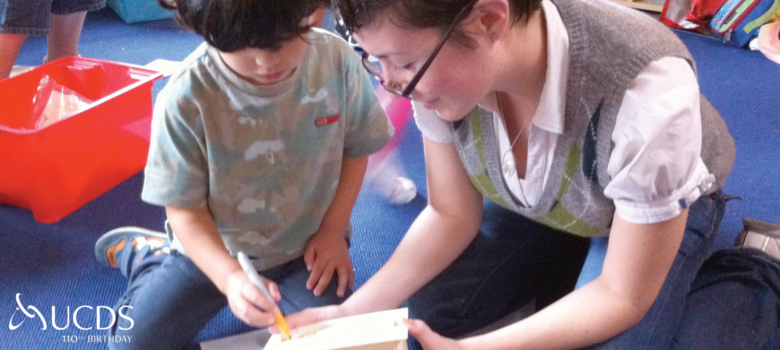This year The Studio decided to implement photography in their curriculum. Teaching the art of photography and how to use equipment can come with some challenges. Infant Teacher, Marianne Sardelich shares about the experience and what she and other teachers observed. -Ed.
– – – –
At the Studio, we utilize small group work in many different ways. We take small groups on trips into the community, teachers facilitate small groups during table activities, and we bring small groups together to discuss something that is happening in the classroom or to make a plan for a project. Six years ago, we decided that we wanted to utilize small groups in a new way. We wanted small groups to be a chance for teachers to cultivate relationships with students, for students to create or develop relationships with other students, for groups to explore ideas and concepts that we might not have time for with the whole class, and for children to build connections between their understanding of the world, new ideas, and the larger community.
Those initial goals for small group experiences have evolved into what we now call Exploring Relationships and Connections or ERC groups. One of my roles is to co-lead each ERC group with a classroom teacher.
This year, one ERC group in particular is doing something that is a little different for us at the Studio and (I think) a little beyond the usual expectations for two and three years olds. This group is studying photography.
A few years ago, the Studio bought a set of kid-friendly cameras. We used them as a way for children to document what happened on walks around the neighborhood or as a prop in the classroom. Children enjoyed taking pictures, playing with the different functions, or using it for games. Our school’s philosophy is inspired by the Reggio Emilia approach which believes that there are a 100 languages that children learn during childhood. Those “languages” are materials like blocks, found objects, or natural items and art mediums like clay, paint, and wire and can all be used by children to represent their thinking about the world around them. Children learn a material’s “language” by experimenting with it, discovering how it works, and using it to represent their thoughts. We had used cameras as a tool but hadn’t really explored them as a language. I began to wonder what would happen if we taught the children how to use a camera? Could we teach photography (how to compose a photo) to three year olds? What would we learn about the children from their photos?
I decided to approach Desirée with my idea because she did not have an ERC Group yet. She loved the questions I was wondering about and suggested that we reach out to Jessica Garrick (the Art Specialist at UCDS) for ideas on how to begin this exploration. Jessica suggested that we use ipads instead of cameras. She had found that ipads were easier for young children to use and they allowed children to immediately see the photos that they had taken. We borrowed ipads from our tech department and began to assemble our group. We decided to choose older students because we felt that although the ipads were easier to use they still required a relatively high level of fine motor skills. We also hoped that the children would learn how to compose a photo and to talk about their photos and we felt that the ability to plan a work and reflect on it was a skill that even our oldest students were just beginning to develop.
It will have to go without saying that teaching the children how to use the camera app on the ipads did not happen overnight. It took about a month, before we began to notice the children taking meaningful photos. By meaningful, I mean the children chose something to take a picture of, took a picture, checked the picture, and sometimes took another picture if the first one wasn’t right. Based on the children’s interests, Desirée and I began to focus photo taking on two types of photos: portraits and nature photography.
The first thing that struck us about portrait taking is how often the children wanted to take self-portraits (better known as selfies). As soon as we taught them how to switch the camera to forward-facing, self-portraits began to dominate their photo stream. The children didn’t pose for the self-portraits unless helped by Desirée or I. Their self-portraits capture the looks of concentration on their faces as they attempt to hold the camera and press the white button to take a photo. Their interest in self-portraits is in line with where our students are developmentally. They are still very interested in themselves, their own feelings and desires, and seeing themselves on the screen might confirm how they see themselves. Their lack of interest in posing suggests that they are not yet considering how to create a particular image of themselves. Interestingly, when the children look at the self-portraits, they are generally more interested in photos of their friends than of themselves.
When the children take pictures of other people, we notice a direct correlation between relationships and photo-taking. For instance, Desirée was one student’s classroom teacher for three years until she moved back to teach in the infant/toddler classroom. She is his favorite subject for portraits and will often call to her when he is ready to take her picture. When children look back at their photographs, they often choose photos of other students or Desirée and I as their favorites. It seems that relationships also increase the personal importance of photos. Desirée and I have also been struck by how quickly the children can identify one another in photos by only the smallest part of a shoe or a blurry photo from behind. All of these examples, support how important relationships are to this age group and how closely they are watching and studying one another.
By looking at the children’s nature photos, we believe we gain insight into how they process the world as they move through it. Our nature photoshoots take place during walks. As we walk, children snap photos or stop to take a picture when something captures their attention. Almost immediately, we noticed that the children took lots of photos of the ground. There were pictures of cracks in the sidewalk, close-ups of rocks, and lots of pictures of shoes. We wonder if this is evidence of how much children look at the ground as they walk. They also tend to take close-ups of things rather than distance shots. Does this reflect how closely young children examine the things that they are curious about? When the children looked back on their photos, all of them selected blurry photos as their favorites. These photos look like they were taken in the middle of action and it made us wonder if they are responding to the motion in the photo or do they more accurately reflect how they see the world. Does the world, to a three year old, look a little bit blurry because of the pace at which they move through it?
As our group continues, we are still wondering about all of these hypotheses and looking for answers to our questions in the children’s photos. We are finding some of the answers by looking at their photos, but we would love to support them in talking about why they chose particular subjects or what they like about their photos beyond just pointing to a person or thing as their answer. Three year olds are just beginning to realistically represent the world and thoughts through painting or drawing. What we find most interesting about the language of photography is that it allows the child to create an immediate representation of their thinking or something that interests them, and is easier for us as adults to interpret. Their photos invite us into their point of view and allow us to consider the world through a new perspective.




